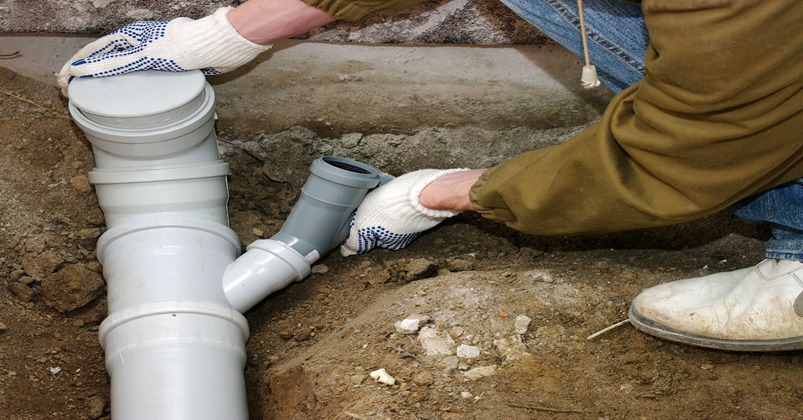Sewerage systems are essential for maintaining the sanitation and hygiene of any residential or commercial property. These systems, often taken for granted, work tirelessly beneath our feet, managing waste and keeping our environments clean. However, like any other infrastructure, sewerage lines are not immune to problems. One of the most common and potentially disruptive issues is sewerage line cracks.
Understanding sewerage line cracks is crucial for property owners and managers. These cracks can lead to significant damage if left unaddressed, resulting in costly repairs and extensive inconvenience. They can cause everything from unpleasant odors and slow drainage to severe water damage and structural issues. By gaining insight into the causes, symptoms, and solutions for sewerage line cracks, you can take proactive measures to maintain your sewerage system’s integrity and ensure the continued safety and comfort of your property.
Common Causes of Sewerage Line Cracks
Sewerage line cracks can occur due to a variety of reasons, each presenting unique challenges and risks. Understanding these causes can help in both preventing and addressing these issues effectively.
Natural Causes
- Ground Shifting: One of the most prevalent natural causes of sewerage line cracks is the shifting of the ground. Soil movement, often due to natural settling or seismic activity, can exert pressure on sewerage pipes, leading to cracks and breaks.
- Tree Root Intrusion: Trees and plants naturally seek out water sources, and sewerage lines provide an abundant supply. Over time, roots can infiltrate small cracks in pipes, expanding them as they grow and causing significant damage.
- Weather Changes: Extreme weather conditions, such as freezing temperatures and heavy rainfall, can also cause sewerage line cracks. Cold weather can cause pipes to freeze and expand, leading to cracks. Similarly, heavy rainfall can lead to soil erosion and shifting, placing additional stress on sewerage lines.
Human-Induced Causes
- Poor Installation: Inadequate installation practices can leave sewerage lines vulnerable to cracking. This includes improper sealing of joints, use of substandard materials, or incorrect placement of pipes, which can all contribute to the development of cracks over time.
- Age and Wear: Sewerage lines, like any other infrastructure, have a finite lifespan. Over the years, materials can degrade, becoming brittle and more susceptible to cracking. Regular wear and tear, combined with the natural aging process, can significantly impact the integrity of sewerage lines.
- External Pressure from Construction: Construction activities near sewerage lines can lead to cracks due to the heavy machinery and excavation work involved. The added pressure and vibrations from construction can weaken and eventually crack the pipes, especially if they are old or already compromised.
By recognizing these common causes of sewerage line cracks, property owners and managers can better prepare and implement preventative measures to protect their sewerage systems. Regular inspections and maintenance are essential to identifying and mitigating potential risks before they escalate into more severe problems.
Identifying Symptoms of Cracked Sewerage Lines
Detecting sewerage line cracks early can prevent extensive damage and costly repairs. Understanding and recognizing the warning signs is essential for timely intervention. Here are some common symptoms that indicate potential sewerage line cracks:
Warning Signs
- Unusual Smells: One of the earliest and most noticeable symptoms of a cracked sewerage line is the presence of foul odors. If you detect a persistent sewage smell around your property, it could indicate a crack that is allowing sewer gases to escape.
- Slow Drains: If your sinks, bathtubs, or toilets are draining slower than usual, it may be due to a crack or blockage in the sewerage line. Slow drainage is often an early sign of a developing issue that needs immediate attention.
- Patches of Lush Grass: While lush, green patches in your yard might seem like a good thing, they can indicate a leaking sewerage line. The nutrients from the sewage can cause the grass above the crack to grow more vigorously than the surrounding areas.
Advanced Symptoms
- Water Damage: Cracked sewerage lines can lead to water damage in your property. This can manifest as damp spots on walls or floors, peeling paint, and the presence of mold or mildew. Water damage not only affects the aesthetics of your property but can also pose serious health risks.
- Sinkholes: In severe cases, sewerage line cracks can cause sinkholes to form in your yard. These occur when the ground collapses into voids created by escaping water from the cracked pipes. Sinkholes are a clear sign of significant sewerage line issues and require immediate professional intervention.
- Foundation Issues: Persistent water leakage from sewerage line cracks can erode the soil around your property’s foundation, leading to structural instability. Cracks in the foundation, uneven floors, and doors or windows that no longer close properly are signs that your foundation may be compromised due to sewerage line problems.
By being vigilant and recognizing these symptoms early, you can address sewerage line cracks before they lead to more extensive and costly damage. Regular inspections and prompt repairs are key to maintaining the integrity of your sewerage system and protecting your property.
Also Read : Birthday Gifts
Effective Solutions for Sewerage Line Cracks
Addressing sewerage line cracks promptly and effectively is crucial to prevent further damage and ensure the smooth operation of your sewerage system. Here are some of the most effective solutions for dealing with sewerage line cracks:
Preventative Measures
- Regular Inspections: Conducting regular inspections of your sewerage system can help identify potential issues before they escalate. Professional plumbers can use advanced tools like cameras to inspect the inside of pipes, ensuring early detection of cracks and other problems.
- Root Barriers: Installing root barriers can prevent tree roots from infiltrating sewerage lines. These barriers redirect roots away from pipes, reducing the risk of cracks caused by root intrusion. Regularly trimming trees and plants near sewer lines can also help mitigate this issue.
Repair Methods
- Trenchless Repair: Trenchless repair methods, such as pipe relining and pipe bursting, are effective solutions for fixing sewerage line cracks without extensive excavation. These methods are less invasive, reducing the disruption to your property and often being more cost-effective.
Pipe Relining: This method involves inserting a flexible, resin-coated tube into the damaged pipe. Once in place, the tube is inflated, and the resin hardens to form a new, durable pipe within the old one, sealing cracks and restoring the pipe’s integrity.
Pipe Bursting: In cases where the pipe is severely damaged, pipe bursting may be necessary. This technique involves breaking the old pipe apart while simultaneously pulling a new pipe into place. This method is particularly useful for replacing old, brittle pipes with stronger, modern materials. - Pipe Patching: For smaller cracks or localized damage, pipe patching can be an effective solution. This involves applying a patch to the damaged area of the pipe, sealing the crack and preventing further leakage.
Professional Intervention
- When to Call a Plumber: While some minor repairs can be handled by property owners, significant sewerage line cracks require professional intervention. If you notice any of the advanced symptoms, such as water damage, sinkholes, or foundation issues, it’s crucial to contact a licensed plumber immediately.
- Selecting a Qualified Professional: Ensure that the plumber you choose is experienced in dealing with sewerage line repairs and uses modern, non-invasive techniques. Checking reviews and asking for recommendations can help you find a reliable professional to handle the repairs.
By implementing these solutions, you can effectively manage and repair sewerage line cracks, ensuring the longevity and reliability of your sewerage system. Proactive measures, combined with professional intervention when needed, can save you from extensive damage and costly repairs in the long run.
Preventative Maintenance and Future Proofing
Preventative maintenance is key to avoiding sewerage line cracks and ensuring the long-term health of your sewerage system. Implementing regular maintenance routines and leveraging modern technologies can help you future-proof your system against potential issues.
Routine Maintenance Tips
- Regular Cleaning: Periodically cleaning your sewerage lines helps prevent the buildup of debris, grease, and other materials that can lead to blockages and cracks. Professional sewer cleaning services use high-pressure water jets to clear out the pipes effectively.
- Monitor Water Usage: Keeping an eye on your water usage can help detect leaks early. Unexplained increases in your water bill may indicate a hidden leak or crack in your sewerage line. Regularly checking your water meter can help you spot any discrepancies.
- Avoid Flushing Non-Biodegradable Items: Ensure that only toilet paper and human waste are flushed down the toilet. Items like wet wipes, sanitary products, and other non-biodegradable materials can cause blockages and put extra strain on sewerage lines, increasing the risk of cracks.
Modern Technologies in Sewerage Line Monitoring
- CCTV Inspections: Utilizing CCTV cameras to inspect sewerage lines allows for detailed, real-time views of the interior of the pipes. This technology helps identify cracks, blockages, and other issues without invasive digging.
- Smart Sensors: Installing smart sensors in your sewerage system can provide continuous monitoring of the pipes. These sensors can detect changes in pressure, flow rate, and other parameters, alerting you to potential problems before they become severe.
- Leak Detection Systems: Advanced leak detection systems use acoustic and infrared technology to identify leaks in sewerage lines. These systems can pinpoint the exact location of a leak, enabling targeted repairs and reducing the need for extensive excavation.
Long-Term Benefits of Proactive Maintenance
- Cost Savings: Regular maintenance and early detection of issues can save you significant amounts of money in the long run. Preventative measures are generally less expensive than major repairs or replacements caused by neglected sewerage lines.
- Enhanced System Longevity: Proactive maintenance extends the lifespan of your sewerage system. By addressing minor issues promptly, you can avoid the wear and tear that leads to more serious problems, ensuring your system remains functional for years to come.
- Improved Property Value: A well-maintained sewerage system contributes to the overall health and value of your property. Potential buyers are likely to be more interested in properties with a reliable, efficiently functioning sewerage system, making your investment in maintenance worthwhile.
By incorporating these preventative maintenance strategies and utilizing modern technologies, you can protect your sewerage system from cracks and other issues. Future-proofing your system not only ensures its reliability but also provides peace of mind, knowing that you are taking the necessary steps to safeguard your property.
Conclusion
Understanding sewerage line cracks and addressing them proactively is essential for maintaining the health and safety of your property. By recognizing the common causes of these cracks, whether natural or human-induced, you can implement effective preventative measures and stay vigilant for early warning signs. Identifying symptoms such as unusual smells, slow drains, and patches of lush grass can help you catch problems before they escalate into more serious issues like water damage and sinkholes.
When cracks do occur, employing effective solutions such as trenchless repair methods and pipe patching can restore your sewerage system with minimal disruption. Regular inspections and professional intervention play crucial roles in ensuring that repairs are done correctly and efficiently. Furthermore, embracing modern technologies like CCTV inspections and smart sensors can enhance your maintenance efforts, offering real-time monitoring and early detection capabilities.
In addition to sewerage maintenance, ensuring your property’s roof is in good condition is equally important. Roof repairs can prevent water damage that may affect your sewerage system and the overall structural integrity of your home. By addressing roof issues promptly, you can protect your property from potential leaks and related problems.
Ultimately, a commitment to preventative maintenance and future-proofing your sewerage system not only saves you from costly repairs but also extends the life of your infrastructure. By investing in routine upkeep and leveraging advanced tools, you can ensure that your sewerage lines and roof remain in optimal condition, safeguarding your property and providing peace of mind for years to come.



